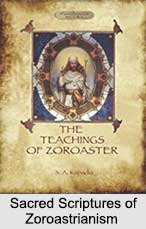 Sacred Scriptures of Zoroastrianism is called the `Avesta` which includes the teachings of Zarathustra written in a series of five hymns called the `Gathas`. They are abstract sacred poetry directed towards the worship of the One God, understanding of righteousness and cosmic order, promotion of social justice and individual choice between good and evil. The rest of the Avesta was written at a later date and deals with rituals, practice of worship and other traditions of the faith. The oldest Parsi scripture is known as `Gatha`.
Sacred Scriptures of Zoroastrianism is called the `Avesta` which includes the teachings of Zarathustra written in a series of five hymns called the `Gathas`. They are abstract sacred poetry directed towards the worship of the One God, understanding of righteousness and cosmic order, promotion of social justice and individual choice between good and evil. The rest of the Avesta was written at a later date and deals with rituals, practice of worship and other traditions of the faith. The oldest Parsi scripture is known as `Gatha`.
The Avesta contains the sacred texts in the Avestan language, whereas the Zend refers to their translations and explanations in Pahlavi.
Division of Sacred Scriptures of Zoroastrianism
When people could not understand the language of the Zend Avesta, then the priests of Parsi religion translated it into Pahlavi, which is the ancient form of Persian language. Later on, it came to be written in Zend (commentary) and Avesta (the language in which it was later written). So it is known as `Zend Avesta`. The Avesta is in five parts which are as follows:
1. Gatha: Its religious core is a collection of songs or hymns, the Gathas, thought to be in the main the very words of Zoroaster. They form a middle section of the chief liturgical part of the canon, the Yasna, which contains the rite of the preparation and sacrifice of Homa.
2. Visperad: The Visperad is a lesser liturgical scripture, containing homage to a number of Zoroastrian spiritual leaders.
3. Vendidad: The Vendidad is the main source for Zoroastrian law, both ritual and civil. It also gives an account of creation and the first man, Yima.
4. Yasht: The Yashts are 21 hymns, rich in myth, to various yazatas (angels) and ancient heroes.
5. Khurda Avesta: The Khurda Avesta (or Little Avesta) is a group of minor texts, hymns, and prayers for specific occasions.
Sects in Zoroastrianism
In India influenced by Hinduism, Zoroastrianism accepted hereditary priesthood. Two sects of Parsis may be distinguished - the Shahanshahis and the Kadmis. Their chief difference lies in that of a fact of history; as to when the fall of the last Sassanian king of Persia (the Yazedegard) took place. The Parsees observe the day of the fall as the Day of Yazdegard, the New Year"s Day.




















